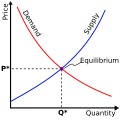JEL classification system
Articles in economics journals are usually classified according to classification codes derived from the Journal of Economic Literature (JEL). The JEL is published quarterly by the American Economic Association (AEA) and contains survey articles and information on recently published books and dissertations. The AEA maintains EconLit, a searchable data base of citations for articles, books, reviews, dissertations, and working papers classified by JEL codes for the years from 1969. A recent addition to EconLit is indexing of economics journal articles from 1886 to 1968[1] parallel to the print series Index of Economic Articles.[2] Developed in the context of the Journal of Economic Literature, the JEL classification system became a standard method of classifying economics literature, including journal articles, books, collective volume articles, dissertations, working papers in economics, book reviews from the Journal of Economic Literature, and EconLit.[3] StructureThere are 26 primary JEL categories:
Each JEL primary category has secondary and tertiary subcategories, for example, under JEL: D – Microeconomics:
JEL code (sub)categories, including periodic updates, are referenced at Journal of Economic Literature (JEL) Classification System. PurposeArticles in economics journals also list JEL codes, facilitating their use across search engines. Comprehensive uses of JEL (sub)classifications include:
Notes
References
External links
|














